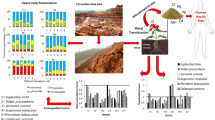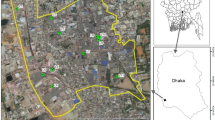Abstract
This study was designed to investigate the concentration of heavy metals and their associated human health risk via consumption of root tubers cultivated in three major communities in Ogoniland, Rivers State, Nigeria. The concentration of heavy metals, especially, Cr and Pb in soil, indicates a moderate contamination (˃ 1.00 mg/kg) level. The concentrations of heavy metals in the root tubers Manihot esculenta, Colocasia esculenta, and Dioscorea alata harvested from Choba, Kpean, and Bodo City ranged from 0.20 ± 0.01–0.84 ± 0.04, 0.01 ± 0.001–0.09 ± 0.02, 0.01 ± 0.002–0.63 ± 0.04, 2.11 ± 0.03–11.8 ± 2.12, and 6.30 ± 1.18–118.6 ± 0.19 mg/kg for Cr, Pb, Ni, Mn, and Fe respectively, while Cd had the same value of 0.01 ± 0.001 mg/kg in the three samples across the three sites. The bio-accumulation factor (BAF) for Cd was ˃ 1. The estimated daily intake were below the FAO/WHO permissible limit, while the target hazard quotient (THQ) has a trend of Mn> Fe> Pb> Cd> Ni> Cr, and were ˂ 1 for all the sampling areas. The HI values for M. esculenta for children in Choba, Kpean, and Bodo City were ˃ 1, indicating that children among the local populace were susceptible to heavy metals health risks. The carcinogenic risk (CR) value of Cr indicates that there was appreciable lifetime cancer risk for Cr as the CR value in all the sampling sites were ˃ 10−4. Furthermore, CR values of Ni and Cd were also within the predicted lifetime risks of carcinogens. Heavy metal contamination of root tubers cultivated in Ogoniland may posed a great health risk to local populace especially for children via consumption of root tubers.

Similar content being viewed by others
References
Loutfy N, Fuerhacker M, Tundo P, Raccanelli S, Dien AG, Ahmed MT (2006) Dietary intake of dioxins and dioxin-like PCBs, due to the consumption of dairy products, fish/seafood and meat from Ismailia City, Egypt. Sci Total Environ 370:1–8
Khan S, Cao Q, Zheng YM, Huang YZ, Zhu YG (2008) Health risks of heavy metals in contaminated soils and food crops irrigated with wastewater in Beijing, China. Environ Pollut 152:686–692
Naser HM, Sultana S, Mahmud NU, Gomes R, Noor S (2012) Heavy metal levels in vegetables with growth stage and plant species variations. Bangladesh J Agric Res 36(4):563–574
Jarup L (2003) Hazards of heavy metal contamination. Br Med Bull 68:167–182
Dyer CA (2007) Heavy metals as endocrine disrupting chemicals. In: Gore AC (ed) Endocrine-disrupting chemicals: from basic research to clinical practice. Humana Press, Totowa, pp 111–133
Nweke FI, Spender DSC, Lynam J (2002) The cassava transformation: Africa’s best kept secret. Michigan State University Press, East Lansing
Osunde ZD, Orhevba BA (2009) Effects of storage conditions and storage period on nutritional and other qualities of stored yam (Dioscoreaspp) tubers. AJFAND 9(2):678–690
Braide W, Nwaoguikpe RN (2011) Production of ethanol from cocoyam (Colocasia eseulenta). Inter J Plant Physiol Biochem 3(3):64–66
United Nation Environment Programme (UNEP) (2011) Environmental Assessment of Ogoniland. ISBN: 978-92-807-3130-9. Job No.: DEP/1337/GE
Onuoha SC, Anelo PC, Nkpaa KW (2016) Nkpaa human health risk assessment of heavy metals in snail (Archachatina marginata) from four contaminated regions in Rivers State, Nigeria. Am Chem Sci J 11(2):1–8
Nkpaa KW, Patrick-Iwuanyanwu KC, Wegwu MO, Essien EB (2016) Health risk assessment of hazardous metals for population via consumption of seafood from Ogoniland, Rivers State, Nigeria; a case study of Kaa, B-Dere, and Bodo City. Environ Monit Assess 188(9):9
Nkpaa KW, Onyeso GI, Achugasim O (2017) Heavy metals levels in shellfish from Bodo City and B-Dere, Ogoniland, Rivers State, Nigeria, and evaluation of possible health risks to consumers. Sustain Water Resour Manag 3:83–91
Nkpaa KW, Amadi BA, Wegwu MO (2018) Hazardous metals levels in groundwater from Gokana, Rivers State, Nigeria: non-cancer and cancer health risk assessment. Hum Ecol Risk Assess 24(1):214–224
Nwankwo CN, Ehirim CN (2010) Evaluation of aquifer characteristics and groundwater quality using geoelectric method in Choba, Port Harcourt. J Sch Res Libr 2:396
Zhang GP, Fukami M, Sekimoto H (2002) Influence of cadmium on mineral concentrations and yield components in wheat genotypes differing in Cd tolerance at seedling stage. Field Crops Res 77:93–98
Adeel M, Riffact NM (2014) Human health risk assessment of heavy metals via consumption of contaminated vegetables collected from different irrigation sources in Lahore, Pakistan. Arab J Chem 7:91–99
Ghosh M, Singh SP (2005) A comparative study of cadmium phytoextrcation by accumulator and weed species. Environ Pollut 133:365–371
Zhuang P, McBride MB, Xia H, Li N, Li Z (2009) Health risk from heavy metals via consumption of food crops in the vicinity of Dabaoshan mine, South China. Sci Total Environ 407:1551–1561
Santillan LFJ, Constantino CAL, Rodriguez GAV, Ubilla NMC, Hernandez RIB (2010) Manganese accumulation in plants of the mining zone of Hidalgo, Mexico. Bioresour Technol 101(15):5836–5841
Rattan RK, Datta SP, Chhonkar PK, Suribabu K, Singh AK (2005) Long-term impact of irrigation with waste water effluents on heavy metal content in soils, crops and groundwater-a case study. Agric Ecosyst Environ 109:310–322
Yu-jun Y, Zhifeng Y, Shanghong Z (2011) Ecological risk assessment of heavy metals in sediment and human health risk assessment of heavy metals in fishes in the middle and lower reaches of the Yangtze River Basin. J Environ Pollut 159:2575–2585
Abdi O, Kazemi M (2015) A review study of biosorption of heavy metals and comparison between different biosorbents. J Mater Environ Sci 6(5):1386–1399
USEPA (2007) Dermal exposure assessment: a summary of EPA approaches (final report), September 2007. EPA 600/R-078/040F. National Center for Environmental Assessment, Office of Research and Development, Washington, DC
Harmanescu M, Alda LM, Bordean DM, Gogoasa I, Gergen I (2011) Heavy metals health risk assessment for population via consumption of vegetables grown in old mining area; a case study: Banat County, Romania. Chem Cent J 5:64
FAO/WHO (1993) Evaluation of certain food additives and contaminants. WHO Technical Report Series NO 837
USEPA (2011). Screening level (RSL) for chemical contaminant at super-found sites. U.S. Environmental Protection AgencyAvailable at: http://www.epa.gov/regshwmd/risk/human/Index.htm.
European Union (2002) Heavy metals in wastes. European Commission on Environment. European Commission DG ENV. E3. Project ENV.E.3/ETU/2000/0058
WHO (2000) Safety evaluation of certain food additives and contaminants. International Programme on Chemical Safety. WHO Food Additive Series 52. ISBN 92 4 166052 X, (NLM classification: WA 712) ISSN 03000923
Molina VB (2011) Health risk assessment of heavy metals bioaccumulation in Laguna de Bay fish products, Philippines. 14th World Lake Conference, Austin Texas. p 1–23
Burger J, Gochfeld M (2009) Perceptions of the risks and benefits of fish consumption: individual choices to reduce risk and increase health benefit. Environ Res 109:343–349
Addis W, Abebaw A (2017) Determination of heavy metal concentration in soils used for cultivation of Allium sativum L. (garlic) in East Gojjam Zone, Amhara Region, Ethiopia. Cogent Chem 3:1419422
Luo C, Liu C, Wang Y, Liu X, Li F, Zhang GG, Li X (2011) Heavy metal contamination in soils and vegetables near an e-waste processing site, South China. J Hazard Mater 186:481–490
Gupta S, Jena V, Jena S, Davi N, Mati N, Radojevi S, Solanki JS (2013) Assessment of heavy metal contents of green leafy vegetables. Croat J Food Sci Technol 5(2):53–60
Santos EE, Lauri DC, Silveira PCL (2006) Assessment of daily intake of trace elements due to consumption of food stuffs by adult inhabitants of Rio de Janeiro City. Sci Total Environ 327:69–79
Chary NS, Kamala CT, Ras DSS (2008) Assessing risk of heavy metals farm and consuming food grown on sewage irrigated soil and food chain transfer. Ecototoxicol Environ Saf 69:513–524
Horiguchi H, Oguma E, Sasaki S, Miyamoto K, Ikeda Y, Machida M, Kayama F (2004) Dietary exposure to cadmium at close to the current provisional tolerable weekly intake does not affect renal function among female Japanese farmers. Environ Res 95:20–23
Mirosławski J, Paukszto A (2018) Determination of the cadmium, chromium, nickel, and lead ions relays in selected polish medicinal plants and their infusion. Biol Trace Elem Res 182:147–151
Winiarska-Mieczan A, Florek M, Kwiecień M, Kwiatkowska K, Krusiński R (2018) Cadmium and lead content in chosen commercial fishery products consumed in Poland and risk estimations on fish consumption. Biol Trace Elem Res 182:373–380
Acknowledgements
This research was done without specific grant from any funding agency in the public, commercial, or not-for-profit sectors.
Author information
Authors and Affiliations
Corresponding author
Ethics declarations
Conflict of Interest
The authors declare that they have no conflict of interest.
Rights and permissions
About this article
Cite this article
Peters, D.E., Eebu, C. & Nkpaa, K.W. Potential Human Health Risk Assessment of Heavy Metals via Consumption of Root Tubers from Ogoniland, Rivers State, Nigeria. Biol Trace Elem Res 186, 568–578 (2018). https://doi.org/10.1007/s12011-018-1330-1
Received:
Accepted:
Published:
Issue Date:
DOI: https://doi.org/10.1007/s12011-018-1330-1




